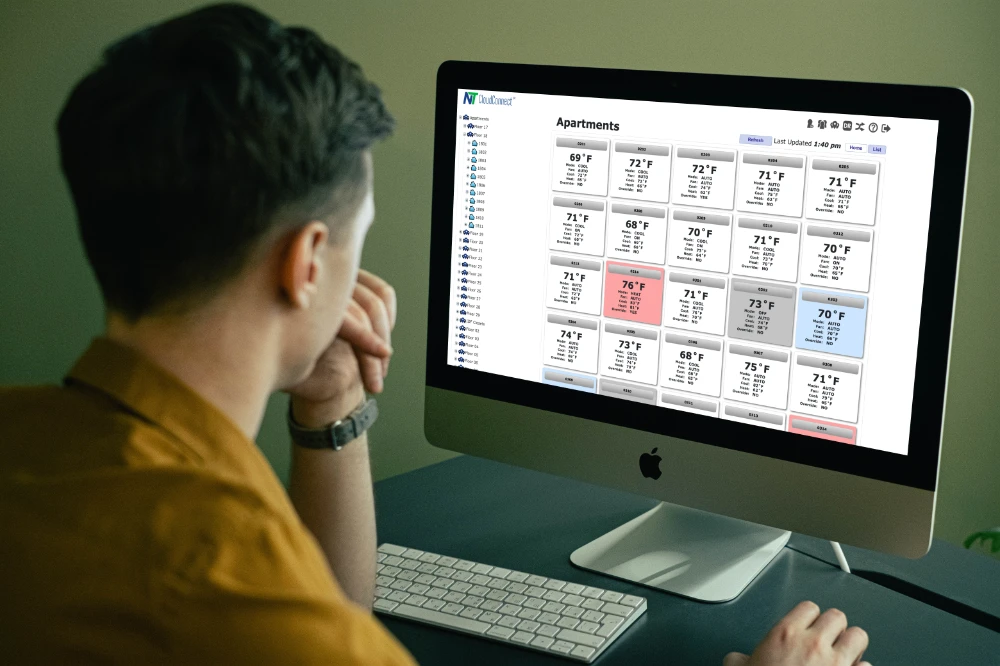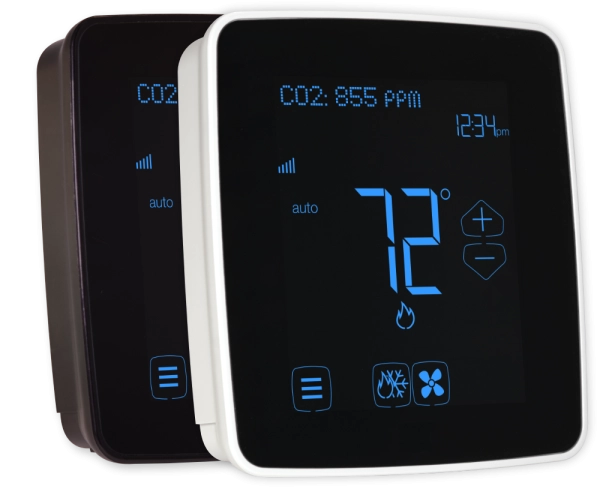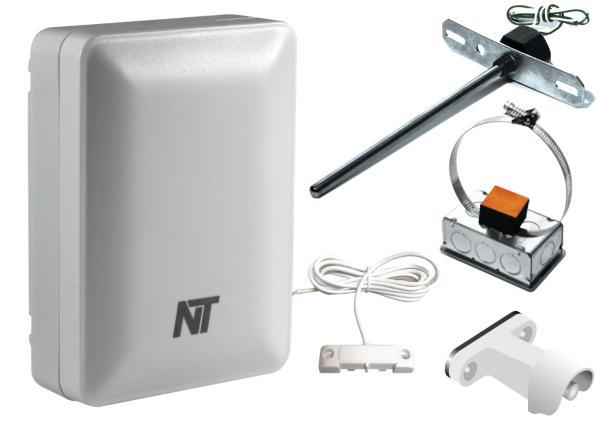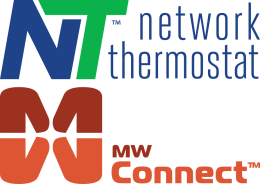
The world of HVAC (Heating, Ventilation, and Air Conditioning) control systems is rapidly adapting to the introduction of additional sensors and smart thermostats. The role that these technologies are playing in existing and new HVAC systems has shifted significantly in recent years, leading to more efficient and cost-effective solutions for the heating and cooling of buildings. These systems ensure that indoor environments remain comfortable and safe for occupants.
Because HVAC systems consume a significant amount of energy (usually the first or second highest monthly energy expenditure in a building), they are a significant contributor to global energy consumption and greenhouse gas emissions. As a result, there is a growing need to improve HVAC system efficiency and reduce energy consumption.
Definition of HVAC Control Systems
HVAC Control Systems start with regulating the temperature and airflow of a building or area to maintain an ideal environment. It consists of components such as dampers, actuators, thermostats, sensors, and control panels. These components communicate as a system and allow user control of temperature in base models, and humidity and air quality in more advanced models.

Importance of HVAC Control Systems in Modern Buildings
By controlling the temperature and humidity levels within a building, HVAC control systems ensure user comfort while conserving energy and reducing operating costs. Through intelligent design and automation, they can also provide occupants with customized indoor air quality settings to suit regulatory and company needs.
In addition to regulating the environment, HVAC controls are deployed in, both the HVAC equipment and the user controls. The combination offers enhanced safety features that automate critical functions such as smoke detection, ventilation, fire prevention, and emergency shutdowns. They help protect against costly damage caused by extreme temperatures or other hazardous conditions while offering occupants peace of mind.
HVAC Control Systems can be programmed to also monitor changes in external conditions throughout the day allowing them to make adjustments. This helps keep the interior climate comfortable while also optimizing energy use. HVAC economizers are often deployed in commercial systems, allowing buildings to open dampers to pull in free outside cool air instead of using the HVAC equipment compressor(s). NetX thermostats include guardbands to be set to better control bringing in fresh air by using both temperature and humidity minimum and maximum parameters.
Role of Sensors and Smart Thermostats in HVAC Control Systems

Sensors play a significant role in HVAC control systems. NetX’s NT-URS Universal Remote Sensor can be used for nearly a dozen sensor types. The data from HVAC sensors is used to inform HVAC controllers about the current conditions of the system, as well as its environment. Each Network Thermostat X5 and X7 thermostat has nearly a dozen sensor types, allowing monitoring and control of not only space temperature and humidity, but also equipment supply air, water leak, door/window, occupancy sensors, and CO2.
HVAC supply air temperature sensors such as the NT-DRS sensor are particularly important, as they provide information to the HVAC technician about the operation of the equipment, helping to determine issues before they become critical. Carbon dioxide (CO2) sensors can be installed inside the NetX thermostats to measure CO2 levels and make sure that indoor air quality standards are being met.
The NetX X5 and X7 Smart[er] thermostats are often a cost-effective alternative to traditional building automation systems. By allowing users to monitor all sensors and control their HVAC systems from anywhere using the NetX-Cloud website and web apps, these devices provide convenience and flexibility for those who want to reduce their energy costs without investing in more expensive solutions.
Components of HVAC Control Systems
HVAC control systems are composed of 3 main components: HVAC units, control devices, and sensors. The HVAC unit is the core element that delivers heated or cooled air throughout a building. They typically consist of either an air conditioner (to cool air) or a furnace (to heat air) and dampers that regulate airflow. Depending on the size of the space and each building’s needs, multiple types and different types of HVAC units may be used to meet those requirements.
Control Devices
Control devices are responsible for operating the HVAC unit efficiently. These include thermostats, which allow users to set the temperature (and sometimes humidity) in their desired range, and to schedule when the system should change operation, turn on and off. NetX’s thermostats include a wide range of unique features that optimize control of the HVAC equipment with smart algorithms, leading to better energy efficiency, lower operating costs, and improved equipment life.
Sensors
HVAC (Heating, Ventilation, and Air Conditioning) sensors can be used to measure temperature, humidity, air pressure, air quality, and other conditions within the equipment. Sensors can also be used to detect changes in the environment that may cause a system failure or malfunction, such as freezing temperatures. These sensors provide real-time data to the thermostats and HVAC equipment.
HVAC Control System Architecture
User Interface
The HVAC Control System architecture relies on a variety of user interface technologies to provide feedback and control capabilities. These include pushbutton and touch-screen controls, keypads, system controllers, and browsers and apps to manage one or multiple HVAC systems using smartphones, tablets, and desktop computers.
These devices can connect directly to the NetX thermostats, which include an embedded web server on each thermostat, allowing the visualization of the current status, scheduling, and alerting from the thermostat. Additionally, visualization and control of large numbers of NetX thermostats can be accomplished using the NetX PC software and from the cloud using NetX-Cloud.
Communications Protocols
Communication protocols are an important part of the HVAC Control System architecture as these allow for communication between the system components. There are many protocols used in HVAC control systems, and the most popular in North America include BACnet and Modbus. Each protocol has its advantages and disadvantages so it is important to select one that best fits your specific needs. NetX thermostats include both BACnet and Modbus, allowing additional flexibility when connecting to commercial HVAC equipment or Building Automation System.
Importance of Proper Installation and Maintenance of HVAC Control Systems
Proper installation and maintenance of HVAC control systems are essential for ensuring that the systems are running efficiently. Regular maintenance should be performed to check the system for any defects or problems. This includes checking filters, fans, coils, ducts, and other parts of the system to make sure they are clean and working properly. NetX Wi-Fi thermostats and Ethernet thermostats include up to 24 different alerts that can be sent to emails and smartphones, giving users and maintenance technicians visibility into the operation and potential issues in real-time.
Additionally, regular preventive maintenance will help identify potential issues before they become serious problems, extend their lifespan, and reduce energy costs associated with inefficient operation.
When choosing an HVAC control system, select a reliable model that has been designed for your specific needs. The installation process should be performed by experienced technicians who are familiar with the system being installed. This will ensure that the components are correctly connected and any wiring or soldering issues are addressed before activation.
Future Developments in HVAC Control Systems
In the future, HVAC control systems are expected to increase their focus on energy efficiency even more. NetX will continue to advance its algorithms to further optimize overall system performance and reduce the amount of energy consumed. In addition, NetX’s algorithms continually self-adjust to achieve the optimal energy consumption rate while still maintaining comfortable conditions for occupants.
HVAC systems will also become more intelligent with the development of Artificial Intelligence (AI). AI-powered software can further analyze data from multiple sources, including weather forecasts and past usage patterns, to anticipate an optimal operating mode that is tailored to the specific application.
By implementing innovative strategies such as these, businesses can enjoy improved efficiency, decreased costs, and better environmental results. With so much potential on the horizon, NetX’s HVAC control systems are poised to be one of the most exciting areas of development in building automation technologies for years to come.
Contact Us for More Information



